Sometimes, new and improved isn’t.
Improved, that is.
The 2020 Toyota Sequoia isn’t new – but that’s because it doesn’t need much improving. Toyota has been selling it the same way since 2008 because . . . it sells.
And you don’t risk improving on that.
What It Is
The Sequoia is Toyota’s full-size SUV, with three rows of seats, body-on-frame construction and a standard V8 that’s more powerful than the smaller V8 that comes standard in newer rivals like the Chevy Tahoe and the twin-turbo V6 that comes standard in rivals like the Ford Expedition.
It also doesn’t use much more gas than the “new and improved,” either – though you wouldn’t know that unless you actually checked the specs. Because most of the car press says otherwise.
Prices start at $49,980 for the base SR5 trim, which – like all Sequoia trims – comes with a 381 horsepower 5.7 liter V8 (vs. the 355 hp 5.3 liter V8 that’s standard in the Tahoe and the 3.5 liter hp V6 that’s the only engine available in the Expedition).
All trims except the off-road-intended TRD Pro can be purchased in 2WD (ear-drive) or with a part-time four-wheel-drive system that lets you select which wheels are powered and when – another thing that the Sequoia has that hasn’t been improved by making it full-time four-wheel-drive
A top of the line Platinum 4WD trim – which includes a load-leveling suspension and power-folding third row – stickers for $69,245.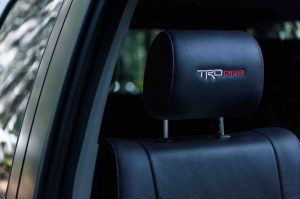
What’s New
The TRD Pro gets Fox heavy-duty off-road shocks, beefier front and rear sway bars, running boards and a tubular roof rack coated with the same no-slip material used for the bedliner in the Tundra pick-up (which is the Sequoia’s sheetrock-carrying fraternal twin) and a pair of Rigid LED fog lights built into the far corners of the front bumper.
Plus M/S tires, special trim and just shy of 10 inches of ground clearance.
Toyota hasn’t improved what doesn’t need to be.
Strongest standard engine in the segment.
Much more cargo room than others in segment.
What’s Not So Good
Tow rating isn’t as high as some of its rivals.
A bit more expensive than some of its rivals.
Could use a larger gas tank.
All Sequoias come standard with the same 5.7 liter V8 that Sequoias have been coming with since 2008.
It makes a class-highest 381 horsepower – without resorting to a turbo and without direct-injection, a form of fuel injection that’s new and improved – but doesn’t provide much improvement, if the measure of that is power.
Or mileage.
The Tundra’s mileage is a little lower than its direct-injected (and turbocharged) rivals.
But only a little.
The 4WD version carries an EPA rating of 13 city, 17 highway. As contrasted with the less powerful Tahoe’s 5.3 liter, 355 hp V8 – which rates 15 city, 22 highway – and the much smaller (and much more complex) Expedition’s 3.5 liter turbocharged V6, which rates 17 city, 22 highway.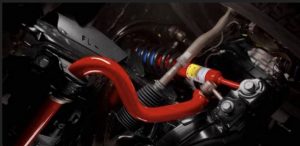
When you factor in the Expedition’s much higher price – $52,810 to start – and the Tahoe’s likely higher down-the-road maintenance costs, due to its V8 being direct-injected – that 2-5 MPG difference doesn’t seem like much of an . . . improvement.
It’s certainly not much of a difference.
A six-speed automatic is standard – vs. the new and improved eight and ten-speed automatics in the competition.
Also available is part-time 4WD.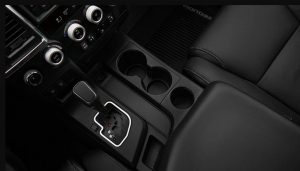
Unlike the new and improved, you can drive a 4WD Sequoia in 2WD – engaging the 4WD as you like. As needed. In rivals, the 4WD is engaged automatically.
As the computer likes.
There is reason not to like this – the first being the loss of control over the 4WD system. Part of the enjoyment of owning a 4×4 is being able to decide when to 4×4. There is another reason to like the part-time system:
Wear and tear – of which there will likely be less, if you use the 4WD less often. There is also the potential for problem of the automatic 4WD system coming on when it doesn’t need to be – and not coming on when you need it to be. o
There’s also no automatic stop/start system (ASS) in the Sequoia – so the engine doesn’t shut off until you shut it off.
Toyota decided that didn’t need improving, either.
The big V8 not only has power. It has sound. On this score, there is no replacement for displacement – irrespective of appetite. Nothing else sounds like a big V8, no matter how powerful – and a big V8 is arguably as vital to a big 4×4 SUV’s appeal as cheese on nachos.
It also doesn’t tick – which DI engines do. Which is why DI engines are muffled under plastic covers, that make it hard to see them or work on them.
Interestingly – because it’s far from being the newest kid on the block – the Sequoia has a tighter turning circle (38.1 feet) than the new and improved Tahoe (39 feet) and a much tighter turning circle than the Expedition (41 feet).
This is no small difference when attempting to U-turn (or park) a vehicle that is 205.1 inches long.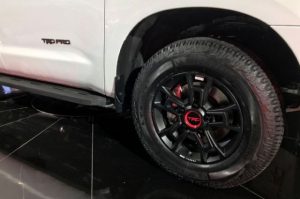
Which is actually not as long as the wider-turning-circle Expedition, which is 210 inches long.
The Sequoia’s body on frame construction isolates you from the road because the frame is isolated from the body by half a dozen rubber biscuits in between the body and the frame. These act as mini shock absorbers in addition to the shock absorbers at the wheels that control the oscillations of the Sequoia itself.
There is a manly, rugged feel to this steel-bodied Toyota that’s lacking in its rivals – which have been new-and-improved to feel more agreeable to suburbanites who use them mostly for kid-carrying and grocery shopping. Both the Tahoe and the Expedition have larger LCD touchscreens, for instance – and these have been given more pride of place on the dashboard, as in cars and crossover SUVs based on cars.
Giving them a more car-like feel.
Toyota upgraded its apps for the 2020 model year but the touchscreen itself is still a peripheral, way off to the right of the driver. But this is compensated for by easier to reach and easier to use knobs and buttons to control primary functions such as radio volume/station and the HVAC system/fan speed as well as secondary functions like the degree of heat you’d like for the seats. Instead of tap and swipe – or buttons with no nuance – there are thumbwheels that allow fine-tuning of the warmth, by feel – without needing to take your eyes off the road.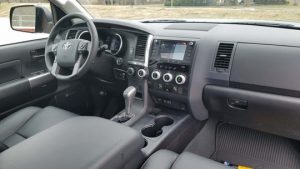
People who prefer meaty will also appreciate the Sequoia’s man-sized console-mounted gear selector, offset toward the driver – vs. the Tahoe’s steering wheel-mounted stalk and the Expedition’s rotary knob.
One small thing that could use improving is the Sequoia’s gas tank – which holds 26 gallons. If it had a 30 gallon tank, it would have more range on a tank than its slightly more efficient rivals – a much simpler way to address “concerns” over mileage than resorting to DI and downsized engines upsized by turbos.
At The Curb
The Sequoia’s styling – which is rounder and smoother than its more angularly styled rivals is a subjective plus – or minus – depending on what appeals to you.
The packaging is an objective plus.
All the SUVs in the full-size class offer three rows of seats but the Sequoia has more space behind its third set of sets – 18.9 cubic feet of cargo space – than the Tahoe (15.3 cubic feet) and much more total space – 120.1 cubic feet – than either that Tahoe (94.7 cubic feet) or the Expedition (104.6 cubic feet).
Note that the Tahoe – which is slightly longer overall, only has 94.7 cubic feet of total cargo-carrying capacity with its first and second rows folded.
There is also more hidden storage capacity in this Toyota, including discreet lidded compartments built into the door panels and a stash place in the center console, adjacent to the gear shifter – covered by a panel that doesn’t appear to be covering anything. It’s an ideal place to store a pistol or wallet out of sight.
There are three USB ports built into the forward part of the console – a nod to modern realities about plug-in accessories. But there is also a 12V power point, something getting hard to find in many of the new and improved. Which is a problem if you need to plug in a 12V accessory like a radar detector.
In the Sequoia, you can.
One of the few functional deficits of this Sequoia is its maximum tow rating – which ranges from 7,000-7,400 lbs., depending on the configuration. This is significantly less rated capacity than the Tahoe, which Chevy says can pull as much as 8,400 lbs.
On the other hand, Ford claims only 6,400 lbs. for the Expedition – which isn’t far removed from what many crossover SUVs can tow.
Probably, all of these ‘utes can tow more than their ratings given what the trucks thy are based on are rated to tow. The Tundra, for instance, is rated to tow more than 10,000 lbs. – and the Tundra and Sequoia are largely the same rig, the latter with a body covering the former’s bed.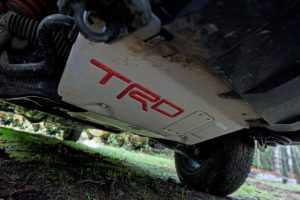
But the main sell here is arguably that the Sequoia is the oldest new SUV of its type on the market.
With the new and improved, you’re always taking a risk – because there’s no track record. How will the Tahoe’s direct-injected engine and ten-speed transmission hold up over the next 12 years? How will the Expedition’s twice-turbo’d V6 and ten-speed transmission hold up over the same time period.
We have a good idea how well the Sequoia’s V8 (and the rest of it) will hold up over the next 12 years because we can refer to the previous 12 years.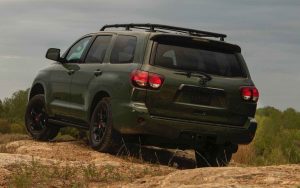
The 2020 Sequoia has been on the market since 2008 – and if it had any design weak points, they’d be known by now.
They’re not known – so you can rest easy about not taking much risk.
And you can avoid some of the known annoyances of the new and improved, especially ASS.
PS: Some inside baseball. The 2021 Sequoia will be largely the same as the ’20 with the exception of a new Nightshade package.
God bless them.
The Bottom Line
If the Sequoia needed improvement, Toyota would have.
. . .
Got a question about cars, Libertarian politics – or anything else? Click on the “ask Eric” link and send ’em in!
If you like what you’ve found here please consider supporting EPautos.
We depend on you to keep the wheels turning!
Our donate button is here.
If you prefer not to use PayPal, our mailing address is:
EPautos
721 Hummingbird Lane SE
Copper Hill, VA 24079
PS: Get an EPautos magnet or sticker or coaster in return for a $20 or more one-time donation or a $10 or more monthly recurring donation. (Please be sure to tell us you want a magnet or sticker or coaster – and also, provide an address, so we know where to mail the thing!)
If you’d like an ear tag – custom made! – just ask and it will be delivered.
My latest eBook is also available for your favorite price – free! Click here. If that fails, email me at [email protected] and I will send you a copy directly!


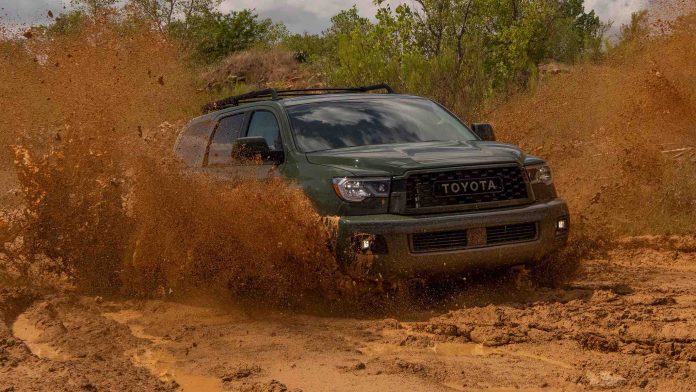

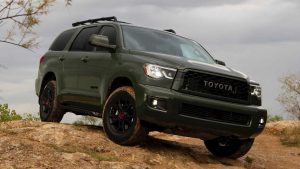
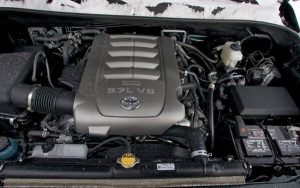
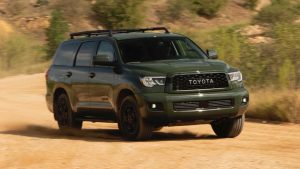
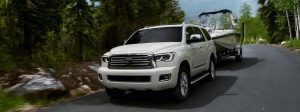

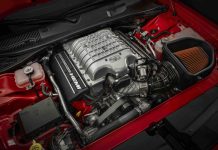






What about the off road Tacoma review? On the fence on purchasing one a 21 when they come out.
Hi Anon,
Hoping I get one soon to do just that! Toyota builds great trucks and SUVs – consistently. I really dig the brand’s general conservatism, too. They don’t fix what isn’t broken. And that’s a pretty rare thing these days, too. Dodge and Ram and Jeep are good in that respect, too.
I loved my sequoia. Hands down one of the best vehicles I’ve owned. There was something cool about loading the thing up to go on a trip with tons of crap and two big dogs, and hear the compressor cut on and level it out.
The other one that I pine for is a 4Runner. Reliable as dirt, rugged as hell.
The only reason I couldn’t replace the destroyed Sequoia with a 4Runner was the wife and her financing weirdness. Had a line on a beautiful 2010. I’m lobbying for a Tundra.
I recently bought a 2017 Sequoia to replace my 2005 Yukon Denali XL. I got 190,000 miles out of the Denali–90,000 all mine–which I bought used in 2010. It started giving me quite a few problems. I owned the vehicle to haul my family around because, as much as I hate SUV’s, I hate mini vans more. When you have five kids, you’ve got to have something big.
I love the Sequoia–I should have known since I have loved my Tundra’s–even though it doesn’t have quite as much length as the Denali XL. I believe that it will give me 300,000 miles with, likely, less problems than the GM. My brother had a 210,000 mile 08 Sequoia and it felt like new when driving. The build quality of Yota’s is much better than what the big three offer. That matters if you are planning on keeping the vehicle for over 100,000 miles. As expensive as these rigs are, I don’t want to buy something every 50,000 miles. Perpetual debt is not my cup of tea.
Another good choice–on the smaller side–is the Lexus GX 470/460. I bought a used 180,000 mile one about 18 months ago. I took the luxury airbag suspension off and replaced it with coils and bilstiens. It’s a beast off road and a pleasure on it.
Yota’s with over 100,000 are the most expensive over 100k vehicles you will buy, but the few extra thousand IMO is worth it. I believe they will give you 100,000 more low/no trouble miles than the truck offerings of the big three.
Ditto, Ancap – as regards both. The Sequoia is the ticket if you need really big – and really strong tow capability. The GX is the ticket if you only need the third row for occasional use and don’t need to pull more than 5,000 or so pounds. It’s also the better off-roader, being narrower.
I’d happily keep either for the next 20 years!
$21K for a 2011 4runner with 143K miles ????
I would say that they’re more expensive!
Anon,
Sometimes the Lexus GX is a sleeper since it’s a Lexus and Lexus buyers are snobs. Not as many people want a high mile lexus as a Toyota sometimes. A GX 460/470 is a 4Runner with a V-8 and a swinging rear door instead of hatch. The third row is fold up like a landcruiser. I’d take the v8 over the six in the 4Runner. The fuel mileage difference is negligible but the power is not.
I don’t really want a high mile anything. I just paid $20K for a 2016 K2500HD with only 72K miles. I don’t see how a five year older 4runner with twice the miles is worth the same money?
We don’t really need the v8 power for towing because we have the pickup. I just want a small/midsize 4×4 SUV with a solid rear axle. I dunno … maybe I should check into the price of a base 4runner (or equivalent) brand new?
Hi Anon,
I’d consider a Nissan Xterra, which is based on the Nissan Frontier. The Frontier is a great little pick-up and the Xterra shares its generally good attributes with the exception of being both slow and and an obnoxious gas hog. But it’s solid axle, pretty simple and if you find one that was treated well – important! – they’re a good bet and a much cheaper date than a 4Runner.
That 4Runner is overpriced. There are GX’s in that age range with similar miles in the 14-18K price range. If you don’t mind something aged, but lower miles–around 100k you should find some options for 12-16 depending on condition. Usually a Lexus is in good condition because of the types that buy them.
RE Eric’s recommendation of Xterra, I had an 04 years ago. I have never driven one newer, but it seemed horribly under powered and never mustered better than 16 mpg’s on the highway. But I live at elevation and hwy speed is 80 mph.
It was very capable off road and I didn’t have maintenance issues with it.
Yeah, Toyota thinks their sheet is made of gold.
Well, I bought it anyway. Dang test drive sold me. I did talk them out of a 2 yr warranty.
The difference in mileage is not critical in the least, economically. Which is true of all four wheel motor vehicles. Fuel is NOT the most expensive portion of driving costs. Except as pertains to the cost of achieving it re government mandate. How smug the drivers of EVs and hybrids are in celebration of their superior gas mileage, while they still suffer similar insurance, tax, depreciation, registration, and some (for EVs) maintenance costs.
Lately I’ve been considering an SUV, not because I like them…I loathe them immensely, but I think I may in fact need one when the time comes to actually live in it and escape the covidiot hordes (and run them over).
Eric, not even joking, can you write an article on what would be the top ten or five choices for both new and used SUV or Pick-ups in a post-apocalyptic, Mad Max word, where you have to mow down rainbow colored Bolsheviks, Mad Scientists with Covidiot shots, and other unsaviories along the road to freedom?
Hi Anon,
Consider it in the works!
Outstanding. I have the Honda Passport and Ridgeline on my list for reliability, but my only concern is if I have to take it offroad…but they are certainly vehicles I can use to make a mobile home base out of.
Speaking of mobile…I think I need to load up on gerry cans.
But also…for these picks, one has to take into account scavengability, to be able to sustain the vehicle when civilization all goes to hell. In that sense, Honda Passport/Ridgeline/Pilot is not a bad choice either, as are the plethora of ‘Yotas, Chevys and Fords and old RAMS. IDK, I’ll rely on your expertise. Ugh…I just don’t like SUVs but it really may be time.
My pleasure, Anon!
Regarding the Ridgeline and Passport: How deep into the Woods do you think you’ll need to go? AWD crossovers can be very capable – especially when the have ground clearance (e.g., Subaru Crosstrek/Outback) and the right tires. Their main weakness off-road is no gear reduction (i.e., Low range, though some Jeep crossovers do have this, too) and that they aren’t as sturdily built. But you can still go surprisingly deep with them. I know because I have.
More soon!
That is good to know!
Low range can be more useful that 4wd/awd. I used to go pretty amazing places in a 2wd pickup with a granny geared four speed. I wish 4wd pickups had a 2-low option.
For off road you need, in this order:
1. ground clearance
2. low gears
3. four wheel drive
For off road you need, in this order:
1. ground clearance
2. low gears
3. four wheel drive